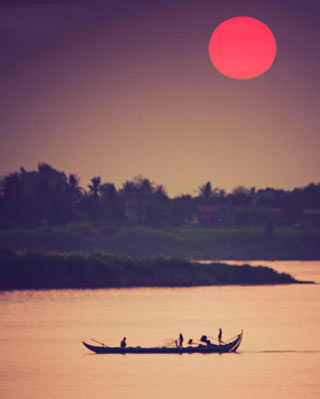Mekong River Cruise: Explore Cambodian Facts Before Visiting
Cambodia’s rich legacy stems from more than two events: the golden pinnacle of the Khmer Empire from the 9th to 14th century and the tragedy of its infamous genocide, both of which have permanently altered the country's cultural and social fabric. In this post, we will introduce a basic understanding of Cambodia one should know before their Mekong River cruise trip.

1. From the Powerful Empire to the Genocidal Modern-day History
If there is anything you should know before you visit Cambodia, it is its history. Most travelers know about the Khmer Empire's dazzling heyday and its mighty capital at Angkor Wat in Siem Reap, but before that, there was a small kingdom of Kambuja-desa plagued by revolts, wars, usurpations, and invasions. Despite the spread of culture, religion, and art in the glittering age, the Khmer empire fell into obscurity after infighting and warfare from more powerful neighbors before the remains of Angkor were popularized in the West by French naturalist Henri Mouhot in 1860.

After independence from the French in 1954, Cambodia’s internal politics became increasingly complicated under Prince Sihanouk's leadership and finally resulted in civil war. What follows is a horrific chapter in Cambodian modern-day history, with 1.5 to 2 million people killed in only four years (1975-1979). The Khmer Rouge regime, originally intended to transform Cambodia into an agrarian socialist republic with no religion, intellectuals, or currency, is named as one of the most brutal and catastrophic upheavals ever perpetrated on a community.

As guests of Mekong River cruises, you will get the chance to visit Security Prison 21 (S21) in Phnom Penh, one of the regime's former concentration centers, now known as the Tuol Sleng Genocide Museum, where visitors can learn about this harrowing period in the country's past.
Cambodians have had to work hard to achieve democracy after losing their infrastructure, intellectuals, cultural, and educational institutions for a whole generation. Despite the tragedy, they are resilient and committed to building a better, more peaceful future.

2. A Unique Culture and Belief System
Through the synthesis of Buddhism and Hinduism with local animistic beliefs, Cambodians have created a distinctive culture and religious system over two millennia. The majority of people in Cambodia are Buddhist, with 80% of them being Theravada Buddhists, 1% being Christians, and the remainder mostly adhering to Islam, animism, or atheism. In Cambodia, Buddhism has been practiced since the 5th century CE. With the exception of the Khmer Rouge regime, Theravada Buddhism has been the official religion of Cambodia since the 13th century CE and today represents 90% of the country's population.

3. Art Achievements from the Golden Age
With inspiration from indigenous animistic beliefs, Hindu and Buddhist teachings, and Chinese and Thai cultures, a distinctive Khmer art style emerged. Thanks to the Sanskrit language, ancient Cambodian culture has a time-honored tradition of oral storytelling, narrative singing, literature, royal chronicles, and epic poetry. At court, classical dance and music were also highly valued. Today, local customs are maintained by singers, musicians, and theatrical performers, while you can also find the gift of song in the villages you visit.

Most of Cambodia’s works of music, dance, art, and architecture come from the Khmer Empire’s output. The architectural and ornamental masterpieces of the golden age, which were greatly influenced by Indian civilization, are exemplified by the massive Angkor Wat and Angkor Thom. These can be seen in the epic sculptural friezes and the Buddhist faces at Bayon that represent the Ramayana and Mahabharata, Hindu deities, along with mythological lions, huge Makara, and naga serpents.
Currently, the most significant artistic endeavors in Cambodia are the restoration of murals in ancient temples, as well as the artisanship of nearly forgotten crafts such as stone carving, ceramics, krama silk weaving, and silversmithing, which you as a Mekong River cruise guest will be privy to.

4. Stoic philosophy in Cambodian life
Most Asian cultures place the importance on the idea of face, in which people behave restrainedly to preserve their dignity, sense of self-worth, and social status. This attribute underlines Cambodians' tendency to remain calm and avoid improper conduct or excessive shows of emotion. Similarly, they want to be treated with courtesy and respect even in criticism, in order to avoid embarrassment.
Despite the tragic background, smiles and positive attitudes are seen everywhere. Forgiveness and harmony appear to be foundations Cambodians rely on to move forward from recent catastrophes, which is not to imply that they do not resonate with them. It is possible that this fact enables people to prioritize respect and devotion to their family, friends, and the collective to maintain peace.

Cambodia is one of the most stunning and unique countries in Asia that you need to witness yourself to believe. Through this post, we hope you've enjoyed reading some facts about Cambodia and are motivated to put this place on your travel bucket list! At Mekong River Cruises, we offer river cruise trips and tour packages to Cambodia and Vietnam, where you may cruise the Tonle Sap, see Angkor Wat, and explore Phnom Penh. Speak with our Mekong Cruise experts for detailed information and wonderful vacations in Asia.
















